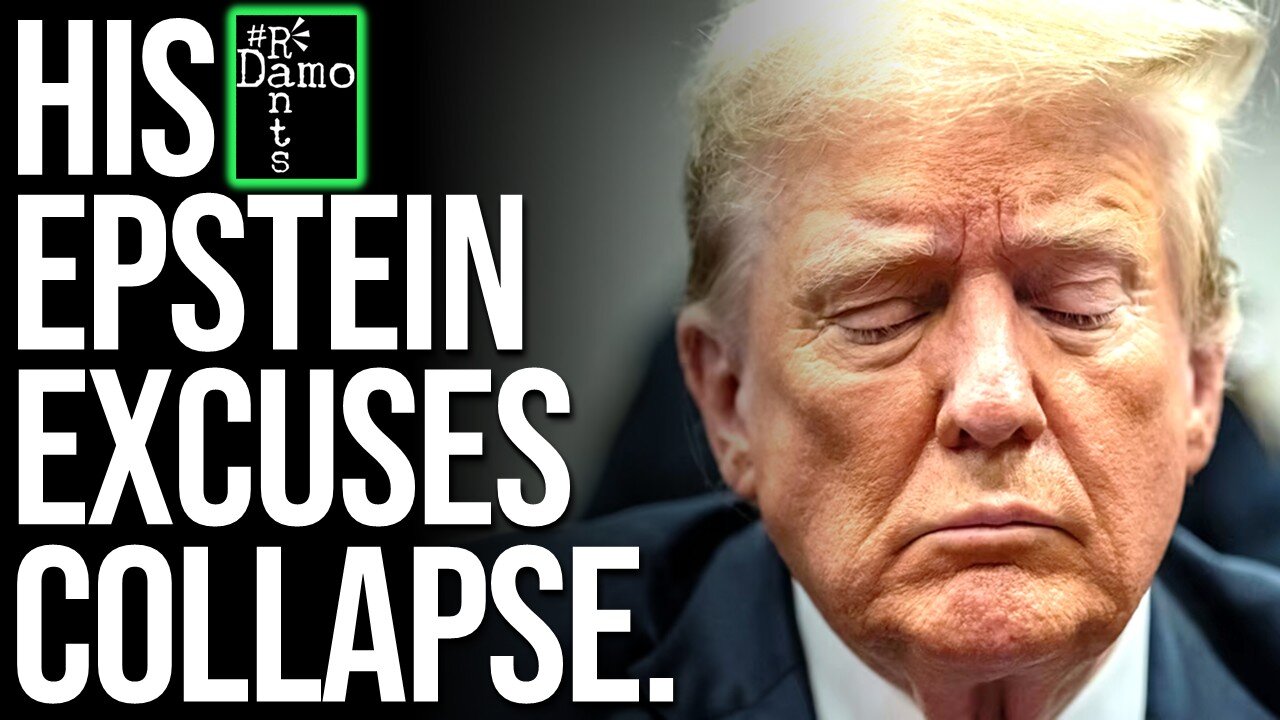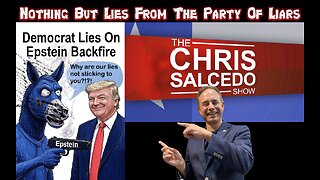Premium Only Content

One Number Just Rewrote ALL of Trump’s Epstein Excuses
Right, so you know when a government dumps twenty thousand documents from the estate of Jeffrey Epstein, you expect the usual names to float to the top, because the press spent years training people to brace for Clinton or some hedge-fund ghoul whose lawyer is always on speed-dial. What you don’t expect, because nobody prepared you for it, is that the most-mentioned man in the entire archive isn’t even Jeffrey Epstein, isn’t Clinton, isn’t Obama, but Donald Trump. One thousand, six hundred and twenty-eight documents. A machine-verified count. More than the trafficker himself. The White House didn’t meet this with calm or curiosity, it went straight to calling it a Democratic smear before most people hade ven opened a single PDF, which tells you they weren’t scared of rumours, they were scared of the count. Because once you know the archive names Trump more than Epstein, more than Clinton, more than Obama, the old “barely knew him” routine doesn’t make it out of the opening line.
Right, so when a government publishes twenty thousand documents from the estate of a convicted trafficker, you expect the names to fall in a certain order, because that’s how the public story has been told for years. You would expect Epstein at the top wouldn’t you? Obviously. You expect the usual orbit of wealthy men who kept turning up in reporting around his movements and his more public friendships, because the media set that frame long before any documents surfaced. What you don’t expect is what the files actually show, which is that Donald Trump, the sitting President of the United States, appears in more of the documents than anyone else. That’s what the data says. Not opinion, not inference, not a political read-in. A machine-verified entity count built on the full 20,000-document release. One thousand, six hundred and twenty-eight documents mention Trump. Epstein himself appears in 1,060. Obama appears in 421. Clinton appears in 392. That puts the President of the United States at the very top of the record of a man whose network ran through trafficking, blackmail, manipulation and elite protection. And once you’ve seen a number like that, you can’t look back at the public lines Trump has used for so long, because soundbites like “barely knew him”, “saw him a few times”, “fell out with him”, and “never saw anything” don’t survive a count like that. The record contradicts the rhetoric. And in politics, that’s where the real story usually starts.
The files themselves didn’t arrive cleanly. The Oversight Committee dumped them in raw form, badly labelled folders, screenshots, inconsistent formatting, multiple layers of redaction, missing metadata. Courier Newsroom had to rebuild the archive just to make it searchable, because the release was closer to a forensic challenge than a transparency exercise. But once it was ingested through Google Pinpoint, the entity panel became visible. That’s where the 1,628 figure comes from. Not a partisan claim, not a journalist’s interpretation, but a numerical fact extracted by software, no more, no less. And the thing about a numerical fact is that it doesn’t care who benefits or who gets hurt; it simply returns what’s in the archive. What it returned was Trump’s name stamped through the estate files more than anyone else’s. And that’s the point where the conversation leaves the realm of ideology, because volume is its own kind of truth. If your name appears that many times in the papers of a trafficker, the question isn’t what you did. It’s why it’s there.
The documents tell you what the references actually are. There’s the 2017 email where Epstein wrote to former Treasury Secretary Larry Summers and called Trump “the worst person he’d ever known”, adding “not one decent cell in his body… so yes—dangerous.” That’s not a fringe opinion. That’s Epstein talking about a man he moved in the same circles with, years after their supposed falling-out. Then there’s the 2011 message to Ghislaine Maxwell in which Epstein wrote that the “dog that hasn’t barked is Trump” and referenced a victim who had “spent hours at my house with him”. The victim’s name is redacted, and the document stops short of any direct allegation of criminal conduct, but the proximity is undeniable. You also see tracking: Epstein monitoring Trump’s movements, logging his travel, watching his fundraisers, pulling articles, noting events. Which suggests a kind of attention that doesn’t match the public story of estrangement and dislike. And I’ll come back to that because it’s one thing for a former friend to keep tabs on you, and another for a trafficker under scrutiny to keep a running record of your movements, years after any claimed falling-out.
Further reporting reporting adds another layer because it confirms the email in which Epstein claimed that Trump “knew about the girls”. That is Epstein’s claim, not independently verified evidence of Trump’s knowledge of underage trafficking. But the presence of the claim in the estate files matters, because it turns what was previously rumour into something the congressional record now contains. And when you combine that with the volume of references, you start to see why the White House came out swinging the moment the documents were released. They didn’t wait for context, interpretation or analysis. They called it a “Democratic smear” before the public had even seen the counts, let alone the details. That defensive instinct tells its own story, because calm governments don’t panic at documents they believe exonerate them. They let transparency take its course don’t they? Panic is what happens when the documents don’t align with the narrative you’ve been selling.
Trump himself didn’t manage it well. Reporters on Air Force One apparently asked about the emails, and the President barked “quiet” at them, because that’s what happens when the political problem is not the question but the existence of the record. And this is why the numerical fact matters. If this was just three emails with redacted names, the White House could drown it in noise. But the volume makes the tactic useless. One thousand, six hundred and twenty-eight document hits is not a narrative to argue with. It’s a wall of evidence you either explain or avoid, and the White House has chosen avoidance. The problem is that Congress has run out of patience.
This is where the mechanics matter. A discharge petition needs 218 signatures. It got them. That forces a vote on the Epstein Files Transparency Act, which obliges the Department of Justice to release every unclassified Epstein-related document in its possession. And this is where the political stakes rise, because the DOJ archive is much larger than the estate files. Reports have confirmed that what we’ve seen so far is only a fraction of what DOJ holds. Ledgers, diaries, calendars, full email exports, digital materials seized by investigators years ago—none of that is in the public domain yet. And I’ll spell it out because this is the moment where the scale becomes clear. If a fraction of the archive puts Trump’s name at 1,628 mentions, the question isn’t whether there will be more in the full set. It’s how many more.
Trump’s defenders have tried to anchor the conversation in what’s familiar: Clinton’s flights, Clinton’s previous friendship with Epstein, old media cycles. But the data doesn’t support that framing anymore, and that’s why this story is dangerous in a way the earlier cycles were not. Clinton appears in three hundred and ninety-two documents. Obama appears in four hundred and twenty-one. Trump appears in over four times that number. The political narrative that always pushed Clinton to the centre collapses instantly when confronted by the record. And this isn’t speculation. It’s a numerical ranking. If you want to understand who Epstein was thinking about, writing about, referring to, tracking and discussing, the list is right there. And Trump is at the top of it.
Now, I’ll deal with the obvious point because it’s the one the White House hangs on: none of this proves criminality. The emails and references do not establish that Trump committed offences or participated in Epstein’s trafficking network. They show association, interest, commentary, criticism, travel logging, and references to shared social environments. They do not show direct involvement in Epstein’s crimes. But that doesn’t rescue Trump from the political crisis, because the problem is not guilt. The problem is proximity. When the estate files of a trafficker contain your name more than anyone else’s, that’s a national security issue, because it raises questions about compromise, leverage and undisclosed relationships. You don’t need conspiracy when you have numbers. And what makes this even more serious is the fact that a sitting President has direct influence over what DOJ does and does not release. That is a conflict of interest so enormous it doesn’t need embellishment. The man most mentioned in the files is the man with the most power over the files. And you don’t need imagination to see why Congress is done leaving this to executive discretion.
The Oversight Committee’s messy release hints at another problem: redactions. Courier Newsroom noted that many documents were heavily blacked out, sometimes to the point of losing context. The DOJ controls redaction policy on unclassified records. They decide what falls under victim protection, what falls under ongoing investigation, and what falls under discretionary privacy shielding. I’m not questioning the legitimacy of protecting victims. That is non-negotiable. But you can see how a government could hide far more than victim details behind a blanket of redaction, because once you wrap it in the language of protection, oversight has to fight uphill to reclaim transparency. And that’s why the discharge petition matters. It forces DOJ into statutory release, and statutory release reduces discretionary silence. In plain terms: it takes control out of the hands of the one person who stands to lose the most from full disclosure.
This brings me to the question that probably matters most, because it gets to the heart of the contradiction. Why did Epstein keep tracking Trump long after the supposed falling-out? Reports show years of attention: counting travel, logging events, monitoring fundraisers, collecting articles. That’s not what you do when a man has no influence on your world anymore. That’s what you do when someone still matters to your ecosystem. And again, this doesn’t prove wrongdoing. It proves proximity. Epstein tracked people when he believed they were useful, threatening, or positioned in ways that touched his interests. That’s the pattern across his correspondence. So when you see Trump marked out as the “dog that hasn’t barked”, you’re looking at Epstein’s own assessment that Trump was a missing piece in a story that otherwise had become public. And that line alone tells you why Trump has always reacted so violently to this story. The public line is one of distance. The private documents show persistent attention and proximity. Politics comes undone when the record contradicts the script.
You also have the problem of institutional memory, because for twenty years this story has been channelled through a Clinton-centric frame. The files break that open. They force the media to confront a documented reality that was hidden behind assumption and narrative momentum. And that matters because it changes the political terrain. Once the data contradicts the long-standing story, you have to ask who shaped the story and why. I won’t speculate on motive because there’s no direct evidence of coordination, at least none that we know of thusfar, but the consequence is obvious: the narrative shield that protected Trump by directing attention elsewhere has fallen. And once the shield drops, the record takes over.
There’s one more point that needs saying because it sits at the junction of power and secrecy. The President of the United States is at the top of the entity count in the estate files of a trafficker, and that President has influence—through DOJ appointments, through executive priorities, through classification culture—over what parts of the remaining archive see daylight. That is not a sustainable position in a functioning democracy. No country can leave the release of compromising material to the discretion of the person most mentioned within it. And that’s why this isn’t a scandal story anymore. It’s a transparency crisis. Congress knows that. You don’t get 218 signatures on a discharge petition unless members in both parties think the risk of suppressing the files is higher than the risk of releasing them. And that tells you everything about where this is heading.
The truth is the White House no longer has control of the frame. The number took that away. One thousand, six hundred and twenty-eight references is not a detail. It’s a structural fact. It’s the kind of fact that forces legislative action, fractures political alliances, and reshapes public narratives. And you can already see the pivot. Republicans who spent years defending Trump on this issue are stepping back because the political cost of defending a statistical outlier of this magnitude is too high. Democrats, obviously, smell opportunity. But the point is not partisan. It’s institutional. If the country is going to take Epstein’s crimes seriously, then it cannot ignore the presence of the sitting President at the top of the estate documents. And if it’s going to claim transparency, then it cannot leave the fate of the remaining files to executive discretion. That’s where this story lands.
So here’s the verdict, because at this point the conclusion writes itself. When the estate files of Jeffrey Epstein mention the President of the United States more than Jeffrey Epstein himself, you’re not looking at a scandal anymore. You’re looking at a national security problem, a transparency crisis, and a political narrative that collapsed the moment the data was released. You can shout at reporters. You can blame Democrats. You can attack committees and Trump I’m sure will continue to do so. But you can’t talk down a number. And that’s the thing Trump has never understood. The record doesn’t care what he says. It only cares what it contains. And right now, it contains his name one thousand, six hundred and twenty-eight times. And that is just for starters.
For as much as its doing Donald Trump untold damage right now, this Epstein story has in a roundabout way, just done Lebanon a massive favour, to do with someone else appearing in the emails that might now give them some leverage so check out the details of that story here.
Please do also hit like, share and subscribe if you haven’t done so already so as to ensure you don’t miss out on all new daily content as well as spreading the word and helping to support the channel at the same time which is very much appreciated, holding power to account for ordinary working class people and I will hopefully catch you on the next one. Cheers folks.
-
 LIVE
LIVE
LFA TV
12 hours agoLIVE & BREAKING NEWS! | MONDAY 11/24/25
2,608 watching -
 LIVE
LIVE
The Chris Salcedo Show
18 hours ago $9.81 earnedDemocrat's House Of Cards Continues Historic Collapse
570 watching -
 1:07:18
1:07:18
Julie Green Ministries
3 hours agoLIVE WITH JULIE
68.8K115 -
 1:31:26
1:31:26
Game On!
16 hours ago $2.47 earnedIt Was ALWAYS A Shedeur Thing! NFL Week 12 RECAP!
16K4 -
 11:55
11:55
Upper Echelon Gamers
14 hours ago $7.19 earnedThe Malware Disaster on STEAM
24.1K2 -
 25:35
25:35
Athlete & Artist Show
17 hours ago $2.19 earnedYOU WON'T FINISH THE GAME!
17.5K -
 13:22
13:22
Silver Dragons
19 hours agoAre You Prepared for What SILVER Will Do Next?
19.4K3 -
 9:20
9:20
Adam Does Movies
21 hours ago $2.65 earnedIT: Welcome To Derry Episode 4 Recap - What An Eyesore
18.2K1 -
 1:30:15
1:30:15
LIVE WITH CHRIS'WORLD
13 hours agoTHE WAKE UP CALL - 11/24/2025 - Episode 12
16.3K6 -
 2:05:00
2:05:00
BEK TV
3 days agoTrent Loos in the Morning - 11/24/2025
12.4K